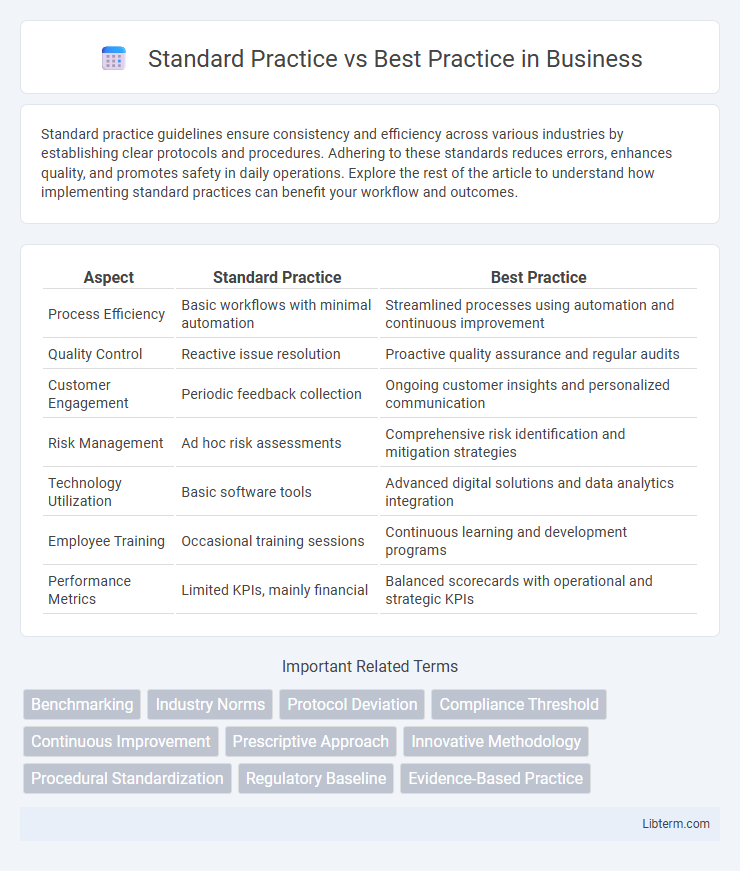Standard practice guidelines ensure consistency and efficiency across various industries by establishing clear protocols and procedures. Adhering to these standards reduces errors, enhances quality, and promotes safety in daily operations. Explore the rest of the article to understand how implementing standard practices can benefit your workflow and outcomes.
Table of Comparison
| Aspect | Standard Practice | Best Practice |
|---|---|---|
| Process Efficiency | Basic workflows with minimal automation | Streamlined processes using automation and continuous improvement |
| Quality Control | Reactive issue resolution | Proactive quality assurance and regular audits |
| Customer Engagement | Periodic feedback collection | Ongoing customer insights and personalized communication |
| Risk Management | Ad hoc risk assessments | Comprehensive risk identification and mitigation strategies |
| Technology Utilization | Basic software tools | Advanced digital solutions and data analytics integration |
| Employee Training | Occasional training sessions | Continuous learning and development programs |
| Performance Metrics | Limited KPIs, mainly financial | Balanced scorecards with operational and strategic KPIs |
Introduction to Standard Practice vs Best Practice
Standard practice refers to commonly accepted methods or procedures widely used within an industry, ensuring consistency and compliance. Best practice denotes the most efficient and effective techniques identified through research and experience, aiming to achieve superior outcomes. Distinguishing between these concepts helps organizations elevate performance beyond basic standards to industry-leading excellence.
Defining Standard Practice
Standard practice refers to the established procedures and guidelines widely accepted within an industry or organization to ensure consistent and reliable outcomes. These practices are often documented, mandatory, and serve as a baseline for operational activities and quality control. Defining standard practice involves identifying the minimum requirements and protocols that align with regulatory standards, safety regulations, and organizational policies.
What Constitutes Best Practice?
Best practice constitutes a set of methods or techniques widely accepted as superior to alternatives because they produce optimum results. It involves continuous evaluation and improvement based on empirical evidence, innovation, and expert consensus within an industry. Unlike standard practice, which often reflects minimum requirements or traditional methods, best practice prioritizes efficiency, effectiveness, and quality outcomes.
Key Differences Between Standard and Best Practices
Standard practices refer to established procedures widely accepted within an industry for consistency and compliance, whereas best practices represent the most efficient and effective methods identified through experience and research. Key differences include adaptability, with best practices evolving to incorporate innovation, while standard practices remain relatively static to maintain uniformity. Implementation of best practices often leads to optimized performance and competitive advantage beyond the minimum requirements set by standard practices.
Advantages of Following Standard Practices
Adhering to standard practices ensures consistency and reliability across processes, reducing errors and enhancing quality control in organizational operations. Standardized methods facilitate regulatory compliance and simplify training, enabling teams to maintain uniform performance and achieve predictable outcomes. Employing established standards also supports efficient resource utilization and fosters smoother collaboration among departments by aligning expectations and procedures.
Benefits of Adopting Best Practices
Adopting best practices enhances operational efficiency by leveraging proven methods that exceed standard procedures, leading to higher quality outcomes and reduced errors. Organizations benefit from increased agility and innovation, as best practices are continually refined based on industry advancements and expert insights. Implementing best practices also boosts stakeholder confidence and competitive advantage through consistent delivery of superior products or services.
When to Apply Standard Practice
Standard practice should be applied in routine, well-defined tasks where consistency and efficiency are essential, such as compliance with industry regulations or safety protocols. It ensures predictable outcomes and reduces variability in processes like manufacturing assembly lines or customer service scripts. Organizations rely on standard practices to maintain operational stability before exploring more innovative or customized best practices.
When to Choose Best Practice
Best practice should be chosen when the goal is to achieve superior results through proven strategies that have been refined over time and validated by industry experts. It is essential in complex projects requiring innovation, efficiency, and long-term success beyond the minimum acceptable standards defined by standard practices. Organizations aiming for competitive advantage must prioritize best practices to optimize performance, reduce risks, and foster continuous improvement.
Challenges in Transitioning from Standard to Best Practice
Transitioning from standard practice to best practice often faces challenges such as resistance to change from employees accustomed to established routines, limited resources for training and implementation, and difficulty in measuring the effectiveness of new methods. Organizations may struggle with aligning best practices to their unique business environments or industries, leading to partial or inconsistent adoption. Overcoming these obstacles requires clear communication, strong leadership support, and ongoing evaluation to ensure that best practices deliver measurable improvements over standard approaches.
Conclusion: Striking the Right Balance
Striking the right balance between standard practice and best practice involves integrating established procedures with innovative improvements tailored to specific contexts. Organizations should continuously evaluate standard practices against evolving industry benchmarks to ensure efficiency and relevance. Emphasizing flexibility fosters adaptation, driving both consistency and optimization in operational outcomes.
Standard Practice Infographic

 libterm.com
libterm.com